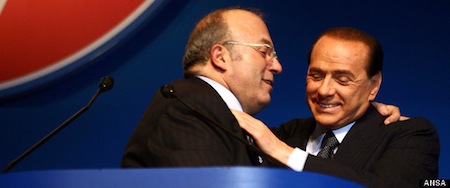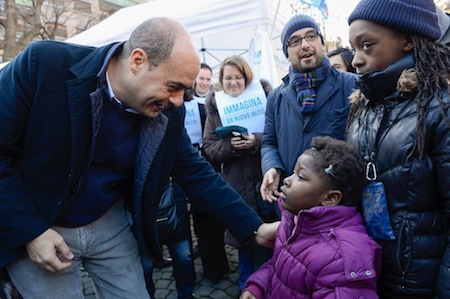In addition to the national Italian elections later this month, with Pier Luigi Bersani leading the race to become Italy’s next prime minister, and in addition to the regional elections in Lombardy, where the centrosinistra (the center-left) is giving the centrodestra (the center-right) a strong challenge in the conservative heartland of northern Italy, the centrosinistra is the strong favorite to win power in Italy’s third-most populous region, Lazio.![]()
![]()
Conservative Francesco Storace, leader of La Destra (The Right), a stridently nationalist party to the right of former prime minister Silvio Berlusconi’s Popolo della Libertà (PdL, People of Freedom), is hoping to return as the regional president of Lazio, following the resignation of the previous government.
The outgoing regional president, Renata Polverini, was elected in 2010 as a candidate of the PdL-backed centrodestra, after previously serving as president of the nationalist, right-wing Unione Generale del Lavoro (General Labor Union), a national Italian trade union.
Polverini, however, resigned in September 2012 after a funding scandal revealed that public funds were being used by members of Polverini’s government for private use.
So like in Lombardy, the key issue in the race is corruption, though her leftist predecessor, Piero Marrazzo, left office amid his own scandal when it was reported that he had been blackmailed by a video recording of Marrazzo cavorting with a transsexual prostitute.
In turn, Marrazzo’s predecessor, Storace, also left office amid the ‘Laziogate’ scandal, whereby Storace was accused of having abused his power to learn more about the members of a new neo-fascist party founded by Alessandra Mussolini.
Lazio has traditionally see-sawed between the left and the right — its capital, Rome, traditionally leans left, and the rest of the province leans right, though even Rome can shift as well. Rome’s mayor since 2008, Gianni Alemanno, is a solidly right-wing PdL politician with ties to Storace and the far right. In the 2010 regional elections, Polverini only narrowly defeated centrosinistra candidate Emma Bonnie, 51.1% to 48.3%.
The likely new regional president is Nicola Zingaretti (pictured below), who since 2008 has been president of the province of Rome, was a member of the European Parliament from 2004 to 2008 and is a member of Italy’s mainstream center-left Partito Democratico (PD, Democratic Party). Predictably, he’s run a campaign calling for more controls over regional spending and an end to the kind of expenses abuse that brought down Polverini.
Storace (pictured below with Berlusconi) remains one of Italy’s more controversial conservatives — in the 1990s and 2000s, he and Alemanno were the leaders of the social conservative wing of the now-defunct Alleanza Nazionale (AN, National Alliance). As the National Alliance moved closer to the mainstream centrodestra in alliance with Berlusconi, Alemanno and Storace found themselves increasingly on the ‘social’ neo-fascist right.
Meanwhile, the National Alliance’s leader Gianfranco Fini moved even further to the center, became an increasingly important member of the Berlusconi government (i.e., foreign minister and later president of the lower house of the Italian Parliament). Ultimately, Fini abandoned Berlusconi, and is now closer to the pro-reform center than to Berlusconi’s coalition, let alone the far right of Alemanno and Storace.

Although both Alemanno and Storace have retained ties with Berlusconi and the PdL, Storace formed La Destra in 2007 and, in the 2008 Italian general election, partnered with the blatantly neo-fascist Fiamma Tricolore (Tricolour Flame). The coalition won 2.43%, not enough to qualify for seats under Italy’s elections law.
The legacy of fascism is never incredibly far from the surface in Italian politics — to this day, despite the proliferation of many parties across the ideological spectrum, Italy’s two main leftist and rightist political traditions follow from the divisions between pro-republic fascists and communist ‘partisans’ that developed at the end of World War II and into Italy’s civil war from 1943 to 1945 (which also explains the uncharacteristically hostile relations between the Italian left and right).
That was on display just last week, when Berlusconi himself caused a firestorm by apparently praising fascist dictator Benito Mussolini.
As regional president of Lazio from 2000 to 2005, Storace won renown nationally for focusing on regional health care and after he narrowly lost his reelection bid in 2005, Berlusconi appointed him as minister of health, though he resigned in 2006 after the ‘Laziogate’ accusations emerged. Storace was elected to Italy’s Senate in 2006, where he’s served for the past six years.
One recent poll shows Zingaretti with a 40% to 32% advantage over Storace (though his lead appears to have narrowed a little since early January), with each of Giulia Bongiorno and Davide Barillari polling around 10%. Bongiorno, a member of the lower house of Italy’s national parliament since 2006, belongs to Fini’s centrist Futuro e Libertà per l’Italia (FLI, Future and Freedom), and she is running as the candidate of a centrist coalition that supports the continued premiership of Mario Monti and that also includes the Christian democratic Unione di Centro (UdC, Union of the Centre). Barillari is the candidate of the anti-austerity protest Movimento 5 Stelle (M5S, the Five Star Movement) of comedian Beppe Grillo.
The Consiglio Regionale del Lazio (Regional Council of Lazio) features 70 members, most of whom are elected via proportional representation. Up to 15 members, however, are elected on the ‘regional list,’ the separate direct vote for regional president — that vote will automatically provide a seat to the elected president and runner-up, as well as additional members for the party or coalition supporting the winner of the direct presidential vote.
Top photo credit to Kevin Lees — Rome, statue of Caesar Augustus holding leftist union flag, Via dei Fori Imperiali, December 2005.


Ciao from Lazio! 🙂